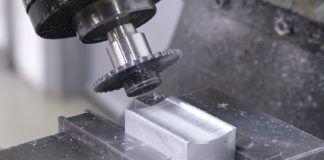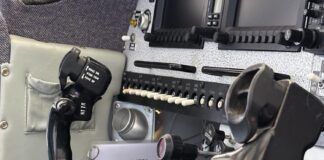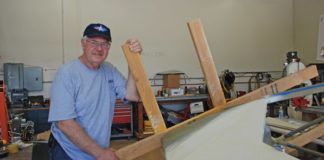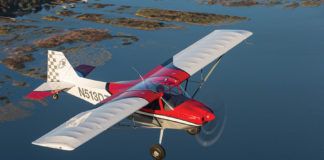It all seemed like it would be so easy. All the pieces of the Solesbees’ Lancair Evolution were beautifully painted and polished, glittering like diamonds in the autumn sunlight. How hard could it be to put it all back together, hook up a few wires and hoses, and launch into the wild blue yonder?
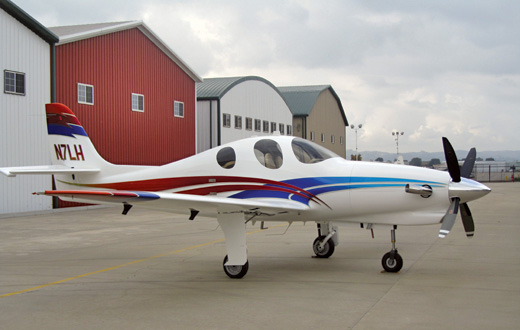
How hard indeed.
Every builder with at least one completed project to his or her credit has heard and lived through the expression, “90% done, 90% to go.” It looks like it’s almost done. Indeed, it is almost done. But somehow it is so hard to wrap up that last little bit. Wendell and Martha Solesbee are dealing with that challenge now. The wings went back on without much trouble. Wendell had learned a few tricks from taking them on and off before, so all he needed was some extra hands to do the heavy lifting. It didn’t take long to rustle up some willing volunteers from around the airport. Wow! That was easy. We’ll be flying next week at this rate.
The gear legs went on next, and the hydraulic actuators. Then the trailing arms needed to slide into place, but they didn’t. The new, improved bushings were too thick. Nothing some time with a belt sander and a file couldn’t cure, but a half-hour project turned into a half-day project.
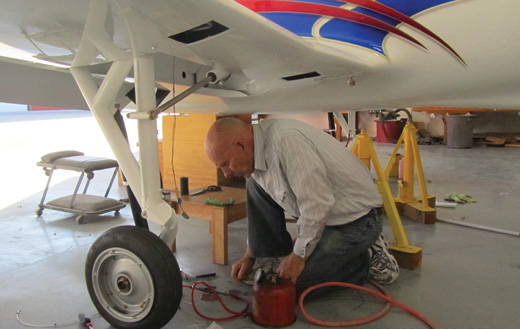
Wendell bleeds the brakes from the bottom up as is standard practice on airplanes. He uses a pressure pot filled with hydraulic fluid to make the job easier. It took a few tries to work all the air out of the system, but the brakes work well now.
Under Pressure
With the landing gear complete it was time to test the hydraulic system. The pump came on. It was supposed to boost the gear-moving fluid to 2000 psi of pressure, but it didn’t. A required adjustment of the pump pressure relief valve in the power pack had slipped through the cracks. This is one of those problems that was easy to fix once you knew what was wrong. Unfortunately, it took time to identify and analyze the problem, and more time to find out how to make the needed adjustment. With the hydraulic pump now churning out 2000 psi of hydraulic fluid, the gear test could proceed, but there was just the tiniest leak coming out of the accumulator. The correct fitting, according to the book, just didn’t work well, so Wendell found a better fitting that didn’t leak.
With the leak under control the gear came up, but the maingear legs hit the hydraulic actuators when they were fully retracted. The people at Lancair advised grinding a bit of metal off the gear legs to get the needed clearance. How could this happen? Remember that the Solesbees are fairly early builders. Lancair later discovered that the original aluminum maingear legs weren’t sufficiently strong, so new ones were developed out of steel. (Ironically, it turns out the gear was strong enough for landing loads, but specific areas could be stressed by pushing the airplane backwards on the ground.) Even as accurate as the Lancair design is, there’s always a chance that clearances will go the “wrong way” when a major part is revised. That’s what happened here. Lancair has once again reworked the landing-gear legs to prevent this problem for future builders. After the modification, the gear worked great, but the gear doors wouldn’t close quite right. The lower arm pivot for the gear doors needed to be raised a little to get the door to swing into place correctly. And so it goes.
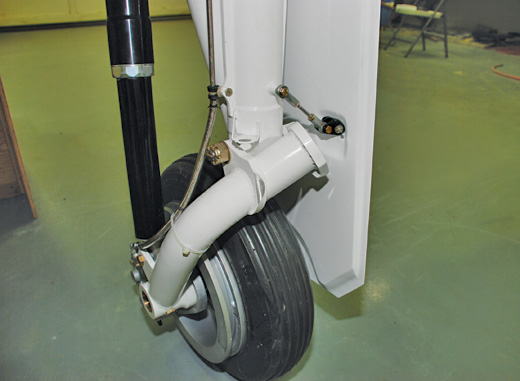
This is one of the improved maingear legs provided by Lancair. It is clearly much stronger than the original, but it had a few minor fit problems that had to be ironed out. Note the small hole below the lower pivot arm attach point and the ground-off metal in the center of the photo. High-pressure tires give the gear a real jet fighter look.
All the mechanical gear parts were now humming along nicely, but the gear-up light for the nosewheel wouldn’t turn on. Wendell tracked it down after spending some time on his back looking up at the underside of the instrument panel. The plug for the relay was incorrectly wired, which no one caught. Like so many electrical problems it was easy to fix but hard to find. Lancair, much to its credit, upgraded the maingear legs free of charge to early builders, but there seemed to be a disproportionate number of little problems surrounding the landing-gear system. One hopes these are all ironed out now.
Getting a Signal
The antennas went in next. Lancair supplies a special copper paint to make the ground plane for each antenna. There actually is copper powder suspended in the paint. You just brush it onto the inside surface of the composite fuselage, let it dry, and there is your ground plane. Most of the ground planes had already been painted on, so Wendell just needed to touch them up as he installed each antenna. What a slick way to handle this task! With a fiberglass airplane most of the antennas can be kept inside the fuselage, but the carbon fiber in the Evolution blocks the signals, so the antennas must go on the outside. The carbon fiber isn’t enough of a conductor to be a reliable ground plane.
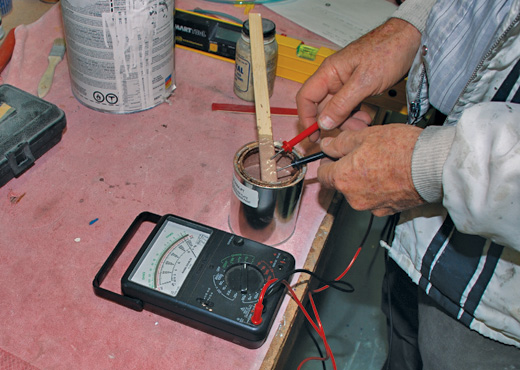
Wendell Solesbee proves the conductivity of the Lancair copper paint with an ohmmeter. Note the resistance is near zero. This is a great way to create a ground plane in a composite aircraft.
The next item to install was the outflow valve for the pressurization system. This valve dumps excess air overboard to maintain the correct pressure level in the cabin. If it doesn’t work, the pressurization system could either fail to maintain enough cabin pressure to keep the occupants safe, or it could let pressure get too high and blow out door seals or even windows at altitude. The valve went in easily enough, but a few small fittings were missing. A drive to a nearby supplier in Ontario, California, kept the project moving along after a brief delay.
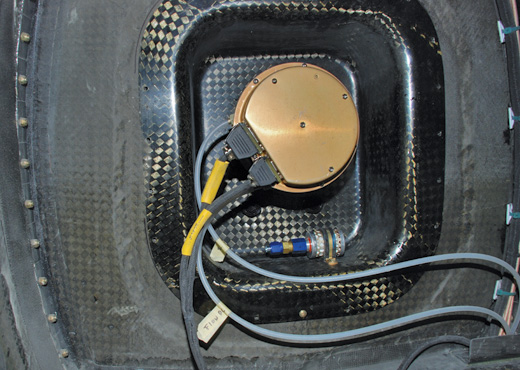
The outflow valve is located on the rear pressure bulkhead. It regulates cabin pressure by venting excess air overboard into the rear of the plane and out of vents near the tail.
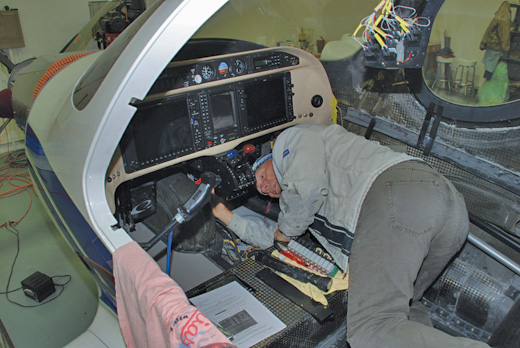
Electrical problems were relatively few and easy to fix, but as is so often the case they were not easy to find. Unfortunately, sorting out problems behind the panel always involves long periods of time in the most uncomfortable position possible.
With the seats in, everything was in place to weigh the plane. First, it had to be leveled and all the various measurements taken to verify the exact position of the landing-gear legs. Without these dimensions it is impossible to compute the moment. With the measurements duly recorded it was time to put the plane on the scales. The moment of truth. How much does it really weigh? The answer turned out to be a gratifying 2469 pounds empty, 6 pounds below Lancair’s target weight of 2475 pounds. This will be the empty weight for the Phase I flight test period. After that the rest of the interior will be added, and the plane will need to be weighed again.
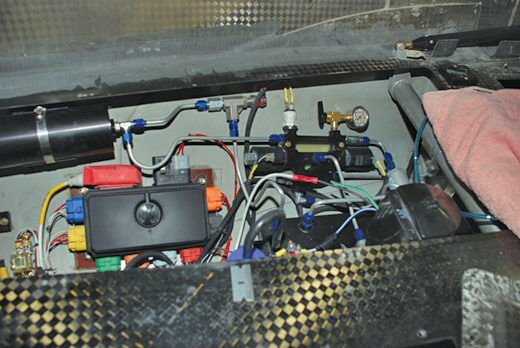
Systems-heavy aircraft such as the Evolution have components strewn all over the airframe. Part of the landing-gear hydraulics live under the baggage shelf inside the cabin.
With weights and arms now in hand it was time to crunch some numbers. Lancair’s weight and balance materials listed the firewall joggle as station 51.25 instead of 78.00 as it should be. All other measurements key off of this one number, so the error produced some goofy-looking numbers. This is an area where the company literature could use a little extra work, but with a call to Mike Fisher at Lancair, the Solesbees were able to get the information needed to complete the task. As it turned out, this plane is a bit nose heavy. A small amount of ballast must be added to the baggage compartment to get things back within center of gravity limits. After the interior is finished and the plane reweighed, that number will have to be recalculated and permanent ballast installed, if required.
If it sounds like this final phase of construction was just one minor disaster after another, that would be the wrong impression. Most things worked exactly as advertised, which is no small victory given the Evolution’s complexity and overall size. All of the avionics and engine instruments work just fine. The starter spins up the engine to 19% Ng—that’s the gas generator part of the turbine, the component the starter actually spins—and that’s above the minimum requirement. The igniters work, though it is too soon to actually start the engine. A detailed check of every system shows that this plane is just about ready to go, and it looks great. Lancair had a few loose ends that needed to be tied up, and the Solesbees missed a detail here and there, but this is normal. In fact, this is pretty darn good. The frustration comes from seeing the end so close but not quite there. Expectations rise about the date of the first flight, bringing pressures that did not exist when the end seemed so much further away. This is to be expected, but the feelings are hard to conceal, even for third-time builders such as the Solesbees.
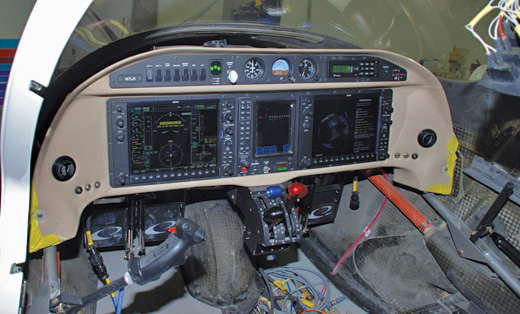
The Garmin G900X panel lights up to the delight of the Solesbees as they near completion of their Evolution. This amazing avionics suite exceeds the capabilities of many commercial airliners.
Bring Me a Rigger, Arrr
Now only a few things remain. The biggest is rigging the engine. Yes, rigging. Piston-engine builders will be asking themselves, “What the heck does rigging an engine mean?” The author asked the same question. If you look at a PT6A engine, you will see a lot of little arms, levers and rods connecting them. Each one of these has to be set to a precise length or position in a specified sequence to make the engine run well. Turbine mechanics call all of this setting and adjusting rigging. Because this requires the skills of an experienced hand, the Solesbees are hiring this out. With that step complete, the only thing left will be the paperwork.
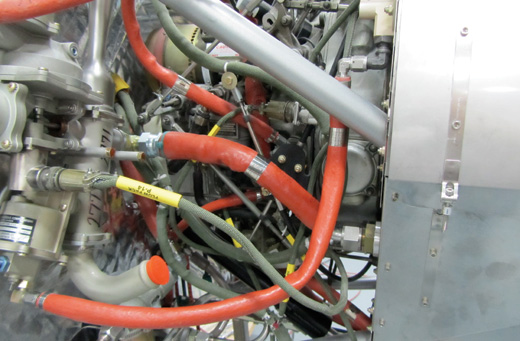
If this looks like a bowl of metal spaghetti to you, don’t feel alone. But to the trained turbine mechanic all of this makes perfect sense. With a little time spent rigging all these arms and levers and rods, this PT-6 should be running like a dream.
If we return to our initial question of whether a first-time builder can really do all of this, it seems apparent that this final assembly and debugging is not something the inexperienced builder would be able to do without help. Some of these problems could be solved over the phone with excellent builder support from Lancair, but others simply need to be addressed by someone who is there with the plane. Hiring help for such things is well within the allowances of the amateur building rules, and it is clearly going to be required at some point for almost every Evolution builder.
In Lancair’s defense, it says a first-time builder can build an Evolution, but it doesn’t say he or she can build it without any help. In fact, Lancair encourages builders to budget about $100,000 for such assistance. This was way too much for the Solesbees, but it may be about right for a novice. Is this too much assistance for a true amateur builder? The FAA does accept it as within the guidelines of AC20-27G, its official publication related to amateur-built airplane construction. In the end, meeting the guidelines depends on the integrity of the builder. The Solesbees certainly have done it, and then some.
It is a tribute to Lancair that such a complicated airplane can be built so easily. It is far easier to build an Evolution than many high-performance kits of 10 to 20 years ago. The Solesbees may not agree that it has been easy, but try to imagine the average A&P mechanic building a Piper Meridian from the ground up. From that point of view the Evolution is a snap to put together. With the judicious use of commercial assistance it truly is possible for a rank amateur builder to construct this amazing airplane.
Next time we go flying. However, before we do there are a few more tasks to complete. As mentioned, the engine still needs rigging and testing. A DAR (Designated Airworthiness Representative) must be selected and application made for an airworthiness certificate. The Solesbees need to do a thorough condition inspection, checking out every single item on the airplane to be sure that it is truly fully assembled and ready to fly. The DAR must sign off on everything and issue the airworthiness certificate and operating limitations, including the location of the flight-test area. Then and only then can N7LH take off on its first flight.
For more information, call 541/923-2244 or visit www.lancair.com.

